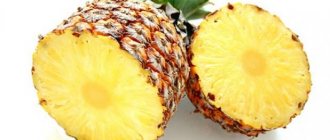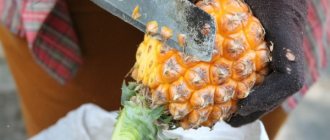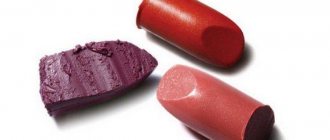Among the fruits and vegetables on the shelves, a tropical fruit, pineapple, stands out noticeably. So bright and fragrant - how it would decorate a holiday table! When buying it, housewives do not think about how to peel a pineapple, and are faced with this problem when guests are on the doorstep. When it comes to peeling, pineapple is not comparable to oranges and bananas, but you can still deal with its thick and prickly peel at home.
Fruit processing and preparation
To prevent cutting a pineapple from becoming a challenge, you need to learn the rules and skills:
- Before cutting the pineapple, it (and the leaves) are thoroughly washed under running water to remove midges, specks, and other dirt.
- For work, take a well-sharpened thin knife.
- The tail leaves should not be torn off: they are held on to, cleaning massive specimens.
- Having cut off the lower part of the fruit, check its stability so that it does not roll off the table or get injured if the knife slips.
- The peel is cut thinner: the layer underneath is the sweetest and most aromatic.
- The “eyes” are removed: these darkish, hard areas spoil the taste and make the fruit aesthetically unattractive. Use a small, sharp knife to avoid catching excess pulp.
- The core is cut off; it is inedible. Hard fibers stand out against the background of the pulp, so they are easy to identify and remove. “Thrifty” people, having tried this part of the fruit, pay with a swollen tongue, a feeling of bitterness and an astringent taste in the mouth. But you shouldn’t throw it away: it is a valuable seasoning for dishes that require cooking.
- Peelings are inedible in any form.
To enjoy the juicy, aromatic pulp, you cannot peel the pineapple in advance - only before serving.
Effectiveness
However, no matter what people say, there is a very good reason why this method actually works. Pineapples grow as individual fruits, the parts of which join together to form a core as they ripen. So, in theory, pulling out pieces of pineapple like the one shown in the video makes a lot more sense than cutting off the skin. However, you should not think that everything will really be as simple as it is in the picture.
How to clean properly
The indigenous population of the tropics, the birthplace of the fruit, taught Europeans how to properly peel a pineapple. Over the centuries, Asians have come up with several ways to peel a pineapple with a knife - intricate and simple. The basic process is simple:
- To carefully peel the fruit and get even slices, you will need a cutting board, ordinary but well-sharpened knives - large and small with a thin blade. Using a potato peeler is not recommended.
- The washed and dried pineapple is placed on a board, the bottom and top are cut off.
- Place the fruit on the cut surface and remove the skin with light movements.
- Cut the peel in a thin layer, in strips. Don't rush, trying to capture several "eyes" at once. Otherwise, a lot of pulp will go into cleaning.
- The result is a golden-spotted “barrel” or “stump”.
- Use a small knife to cut out the eyes. It is easy to distinguish them from the pulp: the spots are denser and darker.
- We cut the “stump” from top to bottom into four parts, removing the core from each.
- Finished large slices - quarters - material for further work. They are easy to cut into cubes, circles, and bars.
Not everyone likes the process, so people came up with the slicer. He is able to cut the fruit almost independently.
Choosing ripe fruit
It’s easy to choose a juicy pineapple if you follow a few simple rules:
- The green “top” should be a rich green color, thick, without yellow spots. The leaves of a ripe pineapple are dense and can be torn off with a slight movement of the hand. If the green tuft does not come out, leave this product in the store. Make sure that the pineapple is sold together with the green tuft. If there is no greenery, then most likely it has rotted.
- The shell of the ripened superfruit is brown, with a slight yellow-greenish tint. Solid brown scales indicate that it is overripe.
- Ripe, fragrant, sweet pineapples are elastic to the touch. If you press a little on the rough surface, it springs back under your fingers. If the surface is soft, then it is better to leave such a product on the store counter.
- Never buy a pineapple if there are visible dents on its surface. Most likely, it will be spoiled inside.
- Feel free to smell this exotic fruit. An excessively cloying smell is a signal that the shell is damaged and putrefactive bacteria are already multiplying inside.
Never buy pineapples for future use. It is almost impossible to create ideal storage conditions at home, and they will begin to deteriorate very quickly.
You may find it useful:
How to properly peel a coconut
Boats for the festive table
This is how cooks from Southeast Asia (and the whole world after them) cut a pineapple:
- The fruit must be cut in half from top to bottom, then in half again. Each quarter is cut to make eight “boats”.
- If the fruit is too small for eight parts, but large for four, it makes sense to cut the halves into three parts. Makes six “boat” slices.
- The core is removed.
- The pulp is trimmed closer to the peel. You need to cut the pineapple without touching the dark seals.
- The pulp is left on the peel, which will be the basis of the “boat”. It needs to be cut into slices no thicker than a centimeter.
- Neighboring triangle segments are moved on different sides, in a checkerboard pattern.
- To prevent the pieces from slipping out of your hands, skewers are attached to them. If there are no skewers, leave the core: it is convenient to hold a slice of fruit.
You can make larger boats and use them as real dishes, filling them with full-fledged food. For example, rice with pineapple. The described method is a solution to the problem of how to serve pineapple more beautifully. He is one of the most popular. Also known as "southeastern", "Thai boats" or "melon".
Method 5
In southeastern countries, pineapple is cut like melon. To do this, remove the edges of the pineapple and, without peeling it, cut it into 4 or 6 pieces. Cut off the core strips from the slices. Then each part is cut with a knife, like a melon, without bringing it to the skin, leaving about a centimeter. You don’t have to cut it into pieces, but bite a whole slice of pineapple - it’s more fun!
We recommend: Storing garlic until next season: ideal places in the apartment
Beautiful spiral patterns
Pineapple can be not only beautifully cut. Gourmets have learned from the Thais how to peel a pineapple at home so that it is pleasing to the eye. They get rid of “eyes” aesthetically by cutting them off in a spiral. To ensure that the procedure is successful and there is a minimum of cleaning, the knife is chosen to be sharp and thin. Procedure:
- The peel is cut thinner, without touching the “eyes”. The top is left: the fruit is held by it during work.
- The “eyes” are removed with a knife, holding the pineapple by the tops and slowly turning it.
- The ideal is a continuous groove-spiral with walls forming an angle. This can be done by professionals. A lightweight solution: cut grooves between three or four adjacent “eyes” and gradually connect them with a solid line.
- Remove leaves and bottom of the fruit.
It turns out a whole patterned pineapple barrel. Serving options:
- cut the “barrel” horizontally into slices-washers; divide them into quarters, assemble them into their original shape, taking into account the pattern;
- cut the fruit vertically into slices with a side-relief.
Regardless of how you cut pineapples, this method removes the core.
Conduct an experiment
If you want to check the reality of this method in practice, then go to a fruit store. When choosing a pineapple, give preference to the one that is the most ripe. If you are unable to find one, then after purchasing, let it sit with you for a while so that it fully ripens and becomes very soft and sweet.
By the way, you can also use another life hack that can help you enjoy the pulp afterwards. You just need to take a ripe fruit and roll it a little on a hard, flat surface. This can loosen the pineapple fibers, allowing the pieces to separate more easily. Such actions may seem funny at first glance, but it is still better not to skip this step.
Rings or circles
If time is short, and you need to serve the fruit in an aesthetically pleasing and original way, cut the pineapple into rings or circles.
Without peel
Classic option:
- The fruit is peeled.
- Next, you need to put it on its side and cut it into even circles.
The core is cut out to create pineapple rings. Or they leave it, informing guests that it is not eaten, but used as a holder for a pineapple slice. It's useful to know how to cut pineapple for a children's table. It is advisable to cut the circles thicker, with the core. It will be convenient for children to pick up halves or quarters with their hands, holding on to it. Do not use toothpicks or skewers - they are dangerous.
With peel
This is a simpler option:
- The bottom of the fruit is cut off.
- The unpeeled pineapple needs to be cut into slices.
- Peel each circle. Remove the thicker skin, along with the dark spots.
- If you want to preserve more pulp, the peel is removed in a thin layer.
- The dark seals are then cut out.
It is easier to cut the flesh using metal cookie cutters that are used to press out shapes. Using a small metal circle of suitable diameter, remove the core evenly. The method is valued because of its speed and ease. Applicable if fruits need to be cut as an ingredient in a dish in the form of simple pieces.
Economy option
It is used “for internal consumption” when you do not plan to eat the whole fruit at once. The top is cut off from a washed pineapple. Next, cut off as many rings as will be eaten now. The peel is cut off from each and the core is removed. The thickness of the pieces is at the discretion of the owner. The rest of the fruit is put into the refrigerator.
Video instruction
https://youtube.com/watch?v=9c75mLzXgGE
One of the most popular tropical fruits is pineapple. Its wonderful taste is difficult to compare with anything, but everyone has probably heard about its benefits. But many refuse to buy it for the reason that it looks exotic and it is not clear how to remove the skin. How to peel a pineapple without damaging the valuable pulp? There are several simple and quick ways to do this.
Fruit box
If you want to amaze your guests not only with the fruit, but also with its presentation, create pineapple “boxes”:
- Since the skin will become a “dish,” wash the pineapple and leaves especially thoroughly.
- The unpeeled fruit must be cut in half - lengthwise or crosswise.
- The pulp is cut out of each part: carefully so as not to damage the bottom. Make rectangular cuts almost to the peel. To ensure that the contours are even after removing the pulp, the knife is stuck into the side of the fruit and led to the “bottom”.
- Remove the core from all parts.
- The extracted pulp must be cut into cubes (up to a centimeter along the edge), placed in a “basket” peel.
Pieces of pineapple, assorted exotic fruits and berries, desserts with ice cream or syrup are placed there.
It is not necessary to leave leaves if they are not particularly aesthetically pleasing. The main thing is to cut carefully, without touching the top of the fruit. An original solution is to build a personal basket with a treat for each guest.
Cutting a pineapple this way takes time and skill. But even sophisticated aesthetes will appreciate the result.
Useful properties of pineapple
Pineapple is not only a very tasty delicacy, but also a storehouse of useful vitamins and microelements. It contains sucrose, iron, copper, calcium, zinc and iodine, vitamins A, B, C, ascorbic and citric acid. It is recommended to be used for problems with the gastrointestinal tract, thrombosis, edema, obesity, etc.
86% of pineapple pulp is water. It is a low-calorie food (100 g of product contains 48 kcal). The potassium salt contained in the fruit improves the body's metabolism and removes excess fluid. One hundred grams of this delicious dish contains the daily requirement of vitamin C and 75% of the norm of manganese to strengthen bones and connective tissues.
When moving through air and water, a glass of pineapple juice will help prevent nausea. Pineapples are often used for cosmetic purposes.
Why remove the peel?
Whether or not to peel a pineapple depends on the type of cooking and serving of the fruit. If the product needs to be cut into pieces or added to a dish, it is recommended to remove the skin. The juiciest edible part is located under the skin. Therefore, the skin must be removed very thinly, using a knife with a sharp blade. If the product is planned to be served as sliced fruit, the tops with skins can be left and used as decoration. To do this, you will need to rinse the pineapple well under running water and dry it with paper towels.
If the fruit is not peeled, it will remain fresh for a long period of time. The skin protects the product from drying out and chapping.
Storage rules
In order for pineapple not to lose its taste, you need to be able to not only choose it correctly, but also choose the right storage conditions:
- The fruit should be stored at room temperature, approximately 15-18 degrees.
- You should not keep it in the refrigerator, as it can lose its aroma in it.
- It is not advisable to move it to a room where there will be a sharp change in temperature.
- The best storage container is a container with special holes.
- Pineapple can maintain its freshness for 12-16 days.
- It can absorb odors, so it should be kept away from foods with strong odors.
- Fruits should not be left in a sunny place.
- Stores sell a special knife that can be used to easily pull out the middle.
- It is not recommended to eat this fruit after eating meat.
Popular articles A pleasant surprise for your loved one on holidays and every day











